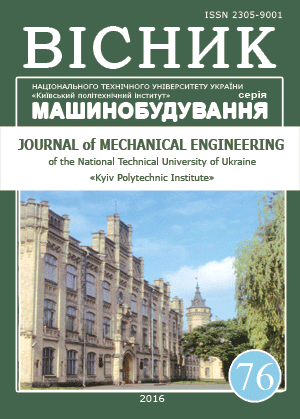NANO-POLISHING SUBSTRATES FOR OPTICS AND MICROELECTRONICS
DOI:
https://doi.org/10.20535/2305-9001.2016.76.67243Keywords:
polished, Single crystals, nanoparticles, colloidal system, roughnessAbstract
As a result of research of polishing single crystal materials it was shown that the polishing flat surfaces of optoelectronic elements of single crystal silicon carbide is advantageously carried out by using a polishing slurry of the powders based on MAX-phase Ti3AlC2 and colloidal nanoparticulate systems, and single crystal sapphire - using suspensions of diamond micron powders of the cubic boron nitride powders and MAX-phase Ti3AlC2. Nano-polishing surfaces of elements of single crystal sapphire should be performed using colloidal nanoparticulate systems or traditional formulations based on colloidal silica. It is also shown that the polishing efficiency of single crystal silicon carbide and sapphire is inversely proportional to the transfer energy, the maximum value of which correspond to a minimum roughness.References
Yaguo Li, Yongbo Wu, Jian Wang, Wei Yang, Yinbiao Guo, and Qiao Xu, (2012). Tentative investigation towards precision polishing of optical components with ultrasonically vibrating bound-abrasive pellets. Optics Express. Vol. 20. No. 1. pp. 568–258.
Yaguo Li, Yongbo Wu, Libo Zhou (2014) Masakazu Fujimoto, Vibration-assisted dry polishing of fused silica using a fixed-abrasive polisher. International Journal of Machine Tools and Manufacture. Vol. 77. pp. 93–102.
Ling Y., Low-Damage Grinding. Polishing of Silicon Carbide Surfaces, SIMTech Technical Report (PT/01/001/PM).
Filatov, Y.D., Filatov, O.Yu., Monteil G. et al. (2011), Bound-abrasive grinding and polishing of surfaces of optical materials. Optical Engineering, Vol. 50, Issue 6, pp. 063401–063401–7.
Filatov, O.Yu., Sidorko, V.I., Kovalev, S.V., Filatov, Y.D., Vetrov, A.G. (2016), Polishing substrates of single crystal silicon carbide and sapphire for optoelectronics. Functional materials. V. 23, No. 1, pp. 104–110.
Wang, Y., Liu, S., Peng, G., Zhou, S., Xu, J., (2005), ‘Effects of surface treatment on sapphire substrates’, Journal of Crystal Growth. Vol. 274. pp. 241–245.
Kadleikova M., Breza J., Vesely M. (2001), ‘Raman spectra of synthetic sapphire’. Microelectronics Journal, No. 32, pp.955–958.
Zhu, H., Tessaroto, L.A., Sabia, R., Greenhut, V.A., Smith, M., Niesz, D.E. (2004), Chemical mechanical polishing (CMP) anisotropy in sapphire. Applied Surface Science. V. 236, Issue 1–4, pp. 120–130.
Budnikov, A.T., Vovk, E.A., Krivonogov, S.I., Danko, A. Ya., Lukiyenko, O.A. (2010), Anisotropy of sapphire properties associated with chemical-mechanical polishing with silica. Functional Materials, Vol. 17, No. 4, pp. 488–494.
Vovk, E.A. (2015), Chemical-mechanical polishing of sapphire by polishing suspension based on aerosol. Functional Materials, Vol. 22, No. 2, pp. 252–257.

